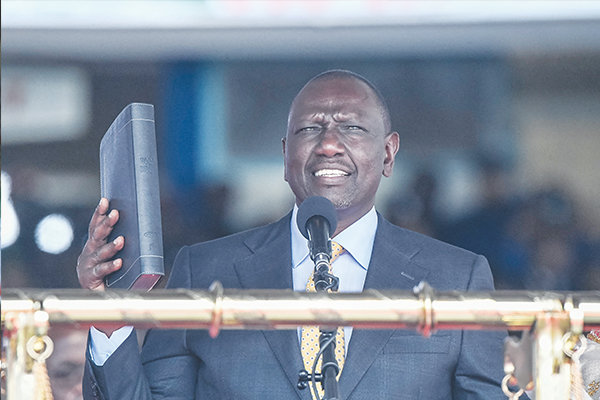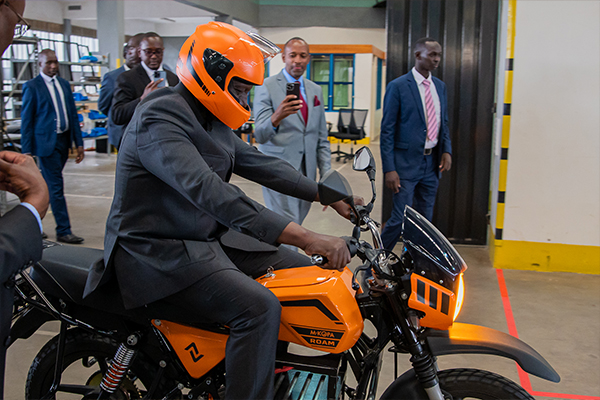#1
HE HON DR WILLIAM SAMOEI RUTO, PhD., CGH.,
PRESIDENT OF THE REPUBLIC OF KENYA, COMMANDER-IN-CHIEF OF THE DEFENCE FORCES
President William Samoei Ruto’s ascent to the highest office in the land in 2022 won him the admiration of millions of Kenyans who relate with the story of his unlikely rise from humble beginnings. The popular tale of how he earned a living in his youth by hawking chickens to travellers on the Nairobi-Eldoret-Malaba Highway has today become something of a legend. “Dreams and ambitions live in the hearts of Kenyans, who struggle daily against daunting odds, often with nothing except stubborn hope,” Dr Ruto remarked in his inauguration speech.
Previously the Deputy President of Kenya between 2017 and 2022, Dr Ruto’s election victory cemented his place as an outlier in Kenyan political history. Unlike many senior politicians, he rose to the pinnacles of political success without the help of a powerful patron working behind the scenes. He also did not hail from a politically connected family. Notably, he was born and raised in the village in rural Kenya, where he spent most of his time working on the farm and herding livestock.

September 13, 2022 during the inauguration ceremony.
The President got his start in politics in 1992 when, fresh from graduating from the University of Nairobi (UoN) with a Bachelor of Science (BSc) degree in Zoology and Botany, he joined Kenya African National Union (KANU), the ruling political party at the time. He worked his way up the party’s ranks and clinched the parliamentary seat for Eldoret North in the 1997 General Elections.
In addition to having been a Member of Parliament (MP), the President has served in several ministerial posts in successive administrations through the years, including stints in key dockets such as Agriculture and Higher Education.
Fast forward, President Ruto won the hotly contested 2022 polls on the campaign promise that his administration would champion an economic development agenda where “hustlers” – the term his campaign team coined for low-income earners mostly working in informal settings – would get a fairer chance at economic participation. His campaign was premised on the idea that ordinary hardworking Kenyans are entitled to enjoy the economic prosperity that has long been the preserve of the rich and connected.
To deliver on this promise, the President and his team developed the Bottom-up Economic Transformation Agenda (BETA). BETA turned the national development agenda upside down from the traditional top-down model that is essentially elite-centric, to a bottom-up model that is inclusive and citizen-centric. The defining feature of the BETA model is a focus on interventions in sectors where the greatest number of citizens find their livelihoods.

The President identified six core pillars that most impact the citizens, which form the basis of his administration’s focus. They include: Agriculture; the Micro, Small and Medium Enterprise (MSME) economy; Housing and Settlement; Healthcare; Digital Superhighway and Creative Economy; Environment and Climate Change. The President indicated that increased investments in these sectors will help bring down the cost of living, eradicate hunger, create jobs, expand the tax base, improve Kenya’s foreign exchange earnings and deliver inclusive and equitable growth.
The first notable area where the President has made progress is cutting the budget deficit, which is projected at 4.4 percent of gross domestic product (GDP) for the current fiscal year (FY 23/24) vs 5.8 percent in the previous year (FY 22/23). Budget deficits reflect the shortfall between government revenues and government spending, translating into reduced appetite for loans.
Another significant achievement during President Ruto’s tenure is the remarkable reduction in fertiliser prices by nearly two-thirds, facilitated through subsidies focused on supporting production rather than consumption. This approach has empowered farmers, ensuring an ample food supply and thereby strengthening food security.

To enhance the effectiveness of this initiative, the government collaborated with Safaricom to develop and implement an e-voucher system for transparent, precise, and efficient administration of the fertiliser subsidy. The e-voucher program targets key crops such as maize, coffee, sugarcane, potatoes, rice, tea, cotton, edible oils, and tomatoes. Thanks to this subsidy, the cost of fertiliser has dropped from KES 7,500 to KES 2,500 since the program’s inception.

President Ruto has also been spearheading efforts to mobilise domestic savings, including devising a new strategy to tap into the billions of dollars in diaspora remittances. A key part of this strategy is the recent digitisation of the process of buying and selling government securities through the Central Bank of Kenya’s (CBK) new DhowCSD platform. The new digital platform allows any Kenyan residing in the country or living abroad to open an account online with the CBK for the purposes of buying and selling government securities.
Furthermore, the President has lent his support to the digital economy. He has on several occasions met leading digital content creators, popularly known as ‘influencers’ to discuss strategies to grow the digital economy. An increasing number of Kenyan youth are earning money posting videos, photos, and written content on popular social media platforms like Instagram, X (formerly Twitter) and TikTok. Some of them get lucrative opportunities as brand ambassadors and marketers or earn revenue through advertising and various forms of e-commerce. Recognising the impact that internet connectivity has spurring growth in the digital economy, Dr Ruto has pledged to provide universal broadband connectivity throughout the country by constructing 100,000 kilometres of new fibre-optic lines, establishing 25,000 free Wi-Fi hotspots in market centres in every part of Kenya, and also building 1,450 digital hubs in every ward of this country.
As part of his efforts to promote greater public participation in the economy, the President has welcomed public debate on his policies. This has been seen with BETA, as well as the Finance Act 2023, which have been the subject of intense debate.

The President’s exploits abroad have earned him the respect and admiration of other global leaders, particularly Heads of State and other senior leaders from Africa. In different global and regional conferences, Dr Ruto has been an ardent supporter of Pan-Africanism, calling for the acceleration of inter-African trade through the African Continental Free Trade Area (AfCFTA).
Of note, the President has on numerous international platforms decried the unfair treatment that Africa receives when seeking affordable financing from international credit markets. He has called for the rethinking of the international financial architecture to address the issues that lead to African countries borrowing at usurious interest rates. He has called out the entrenched biases that lead credit rating agencies to assign unfairly high risk ratings to African countries. These are bold conversations that few leaders are brave enough to have out of fear of unsettling the global financial ecosystem.

Another area of sharp focus in President Ruto’s foreign affairs agenda has been mobilising green financing to accelerate climate action in Kenya and Africa. Speaking at the opening ceremony of the Africa Energy Forum in Nairobi, Dr Ruto noted that despite its threat, climate change presents an opportunity for Kenya and Africa to drum up big ticket investments in the clean and renewable energy sector. “Africa is heavily endowed with clean, green and renewable energy resources as well as the essential minerals required by the global energy transition that humanity must undertake to avert a climate catastrophe,” he said, noting that these new investments can help accelerate climate action while driving socio-economic development through job creation.

Convention Centre (KICC) in Nairobi on September 6, 2023.
Furthermore, during Africa’s inaugural Climate Summit held in September 2023 in Nairobi, President Ruto set exceptionally high standards, earning him a standing ovation and international recognition. In his opening address, attended by over 20 heads of state, he boldly declared, “You have entered the future, a future driven by global partnerships committed to African prosperity, inclusive growth, and a livable planet for all of us. This is no ordinary summit.” His comprehensive speech addressed various critical issues, including the disproportionate impact of climate change on the African continent, the urgent need for increased climate finance, and the promising industrial opportunities arising from the energy transition.

President Ruto also presented an ambitious policy agenda for Kenya. This agenda featured targets such as achieving 100 percent access to clean cooking fuels for Kenyans by 2028, working towards a fully renewable energy grid by 2030, and aiming to establish a massive 100 gigawatt (GW) grid by 2040. Presently, Kenya’s grid capacity stands at 3GW, with approximately 90 percent of it being derived from renewable sources, including 45 percent from hydropower and 20 percent from geothermal energy. HE Ruto has continued to exemplify bold and transformational leadership, the very embodiment of what the African continent urgently craves and deserves at this turning point of geopolitical and climate change discourse.

Like any towering political figure, President Ruto has his fair share of critics. However, if the results achieved in his first year in office are anything to go by, it appears the President will prove the critics wrong once Kenyans take honest stock of his performance at the end of his first term in 2027.
















